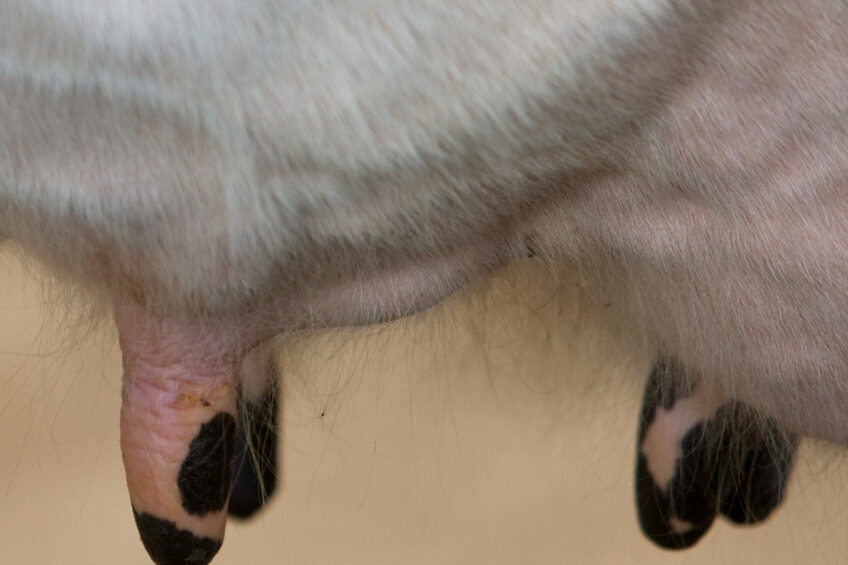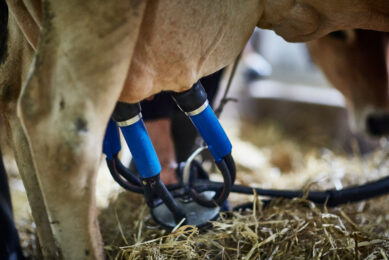Mastitis control starts with a healthy udder

The need to fight mastitis with a reduced amount of antibiotics is growing. Certain supplements, when applied to cow diets can reduce somatic cell counts and hence mastitis incidence. Here we touch on one of these additives, based on 1-monoglycerides of a medium chain fatty acid.
One of the most common and most costly health disorders in dairy cows is mastitis. Dairy farmers need to maintain udder health and milk quality as these parameters directly affect farm profitability. A lot of research has been conducted worldwide to gain insights in how to fight mastitis. Despite all the research done and tools to fight mastitis, there are still farms all over the world that have structural problems with this disease. While antibiotics are still widely used to counter mastitis, there is a growing demand to reduce the use of antibiotics. Non-antibiotic tools to fight mastitis can be found in feed supplements for example.
Economic losses due to mastitis
Mastitis is an inflammation of the mammary gland and is characterised by an increased somatic cell count (SCC) in the milk. In the case of clinical mastitis, abnormal milk is detected, whereas in subclinical mastitis, the milk composition is changed without visually detectable changes. Mastitis is caused by different strains of bacteria that enter the udder. Inside the udder the bacteria will multiply and cause inflammation. Staphylococcus and Streptococcus, both gram-positive bacteria, are probably the most common bacteria causing mastitis. Mastitis results in major economic losses. In general, the overall milk production and milk quality deteriorates. Treatment of mastitis will result in additional veterinary costs. The milk from cows treated with antibiotics will be discarded due to the withdrawal period of antibiotics. In some countries it is even common that the milk price will be reduced in case of a somatic cell count above a certain limit. Moreover, premature culling of cows results in additional losses as well. Furthermore, addressing mastitis problems give rise to extra labour costs and is time consuming.
Feed additives as an effective tool
A lot of solutions have been suggested to reduce mastitis incidence in dairy cows. Besides maintaining good hygiene in the stable and milking house, improvement of udder health will be one of the key aspects to avoid mastitis problems. The company FRAmelco has developed the product FRA® Udder Health dry (hereafter called ‘solution’), based on a new molecule, that can lower the somatic cell counts in milk when applied over a longer period of time. The product is a combination of α-monolaurin, a zinc product and micro-ingredients. The rumen-protected α-monolaurin, the main active component in the solution, is a 1-monoglyceride of lauric acid. 1-Monoglycerides of medium chain fatty acids are known to inhibit gram-positive pathogenic bacteria, like Staphylococcus and Streptococcus, which are known to cause mastitis. The zinc in the solution is a nano-sized zinc embedded in a matrix of medium chain fatty acid salts. This coating technique and coating material ensure stability during feed processing and the preparation of the total mix ration (TMR). Next to that, interaction with other components will not occur as the minerals remain protected inside the fat matrix until they reach the beginning of the small intestine. Zinc is known as an essential trace element and is especially important for the defense mechanism against pathogens in the udder. This is explained by the fact that zinc is required for the formation of keratin. Keratin is present in the teat canal and inhibits penetration of bacteria. In addition, keratin is important for the functioning of macrophages, which are cells present in the udder and are involved in the protection against pathogens in the mammary gland.
Trials performed in the field
This nutritional solution can be applied either via the premix in concentrated feed, top dressed or in TMR on farm. It can also be mixed and spray dried with rumen bypass fat. The solution has shown to be able to reduce the incidence of clinical mastitis. This can result in lower treatment costs, reduced milk waste and increased milk production. Hence, economic losses due to mastitis are tremendously reduced. Several trials conducted at different commercial farms in various countries show that the solution is also able to reduce the SCC in milk. In a trial in Ireland (2014), the solution was supplied on top of the feed of 74 dairy cows at a dairy farm. A dose level of 50 gramme per cow per day was used. Bulk somatic cell count was measured weekly. As shown in Figure 1, a gradual reduction of SCC from 320.000 cells/ml to 179.000 cells/ml occurred within five weeks. At a commercial farm in France (2014), 80 dairy cows received the solution on top of their feed. A dosage of 25 gramme per cow per day was used for a period of one month. Somatic cell count was measured individually and average bulk SCC was recorded as well. Measurements were done 5 and 27 days after the start of the trial. Based on the individual somatic cell count in the milk, cows were classified as either healthy (SCC between 0 and 249.000 cells/ml), infected (SCC between 250.000 and 449.000 cells/ml) or severely infected (SCC above 450.000 cells/ml). The results are shown in Figure 2. The percentages of infected and severely infected animals were both reduced by 5 percentage points (%). Hence, the proportion of healthy animals increased by 10 percentage points (%) within one month. Furthermore, the average bulk somatic cell count decreased from 617.000 cells/ml milk at day 5 to 213.000 cells/ml milk at day 27. This means a decrease in somatic cell count of more than 65% within one month.
Reduction in veterinary costs
In the trials at several farms, it was shown that SCC can be controlled by adding certain supplements to the diet. Using a coating technique ensures that the active ingredients of the solution described in this article are rumen-protected, and allows for a target release. The antibacterial effects on gram-positive bacteria, like Staphylococcus and Streptococcus, further improve udder health. In addition, the solution has beneficial effects on the immune function through improvement of the physical defense mechanism of the udder. As a result, it reduces mastitis incidence and SCC, which in turn reduces veterinary costs and boost farmers’ profitability.
Join 13,000+ subscribers
Subscribe to our newsletter to stay updated about all the need-to-know content in the dairy sector, two times a week.










